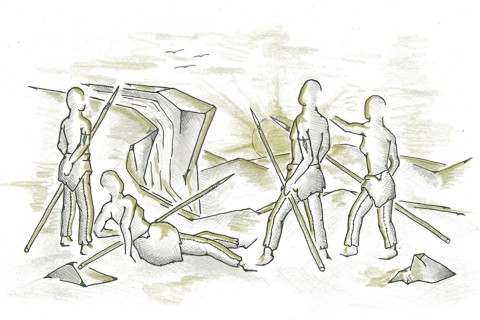The role of women in the Stone Age … quite different than previously thought. (Part 1/2: The view of archaeology)
Where does the image of hunting men and gathering women come from?
The basis of the idea of gender-differentiated role distributions are ethnographic travelogues, such as those by Claude Lévi-Strauss. Many authors wrote from their patriarchal self-image and thus subjectively and judgmentally. The reports often painted a distorted picture and were based on the widespread role model of men as providers and women as housewives.
It was probably quite different
New ethnographic studies from Africa, America and Australia show that non-European cultures did and do have hunting women. In various pygmy groups, for example, men, women and children from five years participate in net hunting. Women here participate in hunting again just a few days after giving birth.
Archaeological research in North and South America revealed an almost equal distribution of roles. Of 429 Stone Age individuals examined, 27 could be assigned to the hunter role. Of these, 11 were female and 16 male!
Outdated role models also influence the historical interpretation of other epochs. For example, in the case of Celtic princely tombs. Or should we rather speak of princess and princely tombs?
Although Celtic princesses have also been known for some time, as evidenced by the tomb of Vix in France, for example, burials are often judged by gender stereotypes. If, for example, a woman and a man are found in a burial chamber, it is inevitably clear that the man must have been the prince and the woman followed him into the grave. And even in the case of the princess of Vix, outdated ideas about what a woman should look like can be found in the pictorial reconstructions.
Archaeological gender research has been practiced in German-speaking countries for 30 years. However, this branch of research increasingly received public attention only a few years ago.
Have more interest in the topic?
Here are two further links:
https://www.femarc.de/en/
https://www.nmbiel.ch/virtual-tour/?lang=de (virtual exhibition ICH MANN.DU FRAU. Neues Museum Biel) Only in German and French
Literature:
B. Röder (Hrsg.), Ich Mann. Du Frau. Feste Rollen seit Urzeiten? Begleitbuch zur Ausstellung des Archäologischen Museums Colombischlössle (Freiburg i.Br. 2014).
R. Haas, J. Watson, T. Bounasera, J. Southon, J.C. Chen, S. Noe, K. Smith, C.V. Llave, J. Eerkens, G. Parker, Female hunters of the early Americas. Science Advances 6, eabd0310 (2020).
B. Röder, Beutejäger und Nesthüterin. Trügerische Orientierung an einem steinzeitlichen Traumpaar. In: B. Rendtorff, C. Mahs, A.-D. Warmuth (Hrsg.), Geschlechterverwirrungen. Was wir wissen, was wir glauben und was nicht stimmt (Frankfurt a.M. 2020), 69-76.
https://www.zeit.de/kultur/2020-08/geschlechterklischees-archaeologie-kelten-graeber-kulturhistorische-deutung-patriarchat

